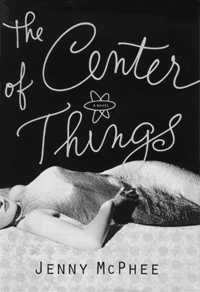
REVIEW
The Center of Things
By Jenny McPhee
Doubleday 2001, 248 p.
$22 (Hardcover only)
Centering Techniques
The quips and quotients of love, life and reality as we know it
By Heidi Broadhead
 It's always a relief when your light summer reading turns out to be something more substantial, something that questions reality and lets you enjoy the questioning. Am I really sitting here on the beach? Am I really reading a book? Am I me? It's always a relief when your light summer reading turns out to be something more substantial, something that questions reality and lets you enjoy the questioning. Am I really sitting here on the beach? Am I really reading a book? Am I me?
The Center of Things centers on Marie Brown, a tabloid journalist, physics connoisseur and adoring fan of Nora Mars, B-movie actress extraordinaire, who has more quotable quips than Mae West, Barbara Stanwyck, and Marilyn put together. As the novel opens, Nora is in a coma after a massive cerebral hemorrhage. Marie begs for the assignment to pre-write Nora's obituary, seeing it as a promotion opportunity and personal challenge after wiling away ten years rewriting other people's articles.
Marie spends her free time at the Science, Industry, and Business Library trying to finish a graduate paper on physics, which she's been working on for 15 years. She spends hours spewing out theories - from big bang to quantum mechanics, et al. - to Marco, a "freelance intellectual" who also hangs out at the library. McPhee uses these discussions to take the reader through such sticky concepts as time, truth, beauty, jealousy, money, science, love, reality, death, and life. At the center of things is science, the language Marie uses to ground herself and her connection to the men who truly understand her, Marco and her brother Michael, both of whom are really just extensions of Marie and who speak so much in her voice that at various points I wondered if these characters existed as anything more than a "particle" of Marie's imagination. In fact, Marco even says it at one point, "� you and I, Marie, are actually the same person, or, if you like, opposite sides of the same person, like entangled particles." This blurring of character identity fits perfectly with at least one argument of the novel: that the existence of matter depends on perception, just as the meaning of a novel depends on its reader.
Although physics is the metaphorical core of the novel, what fuels the story is Marie's Rosebudian search for the various and sometimes contradictory "true facts" of Nora's life. Marie finds herself absorbed in a cast of characters she had only imagined in movies, and at the crux of a mystery that she may or not be able to solve, but it mirrors the mysteries of life, of her identity, and of her fate if such a thing exists. Nora acts as a sort of alter ego for Marie, getting her out of the library and into the sticky mess that is life in the spotlight.
Developing the periphery characters merely as an extension of the main character is risky. Luckily, Marie is a complex character, and with her constant internal arguments, ego flim-flams, and ambivalence about societal expectations for education, career, and marriage, she is able to carry an entire novel.
For a first novel The Center of Things demonstrates a lot of complexity, both in Marie's character and in the weaving of the physics, film history and plot. However, as may be expected with a first novel, it wraps up a little too neatly. All in all, though, it is worth the journey, if only to read the luscious meanderings between the well-crafted quotes from Nora Mars, such as the following, which miraculously appears as Marie starts to resolve some of her inner conflicts:
"Among all your possible lives, you have to anchor yourself to one to be able to have the most fun in the others."
|

